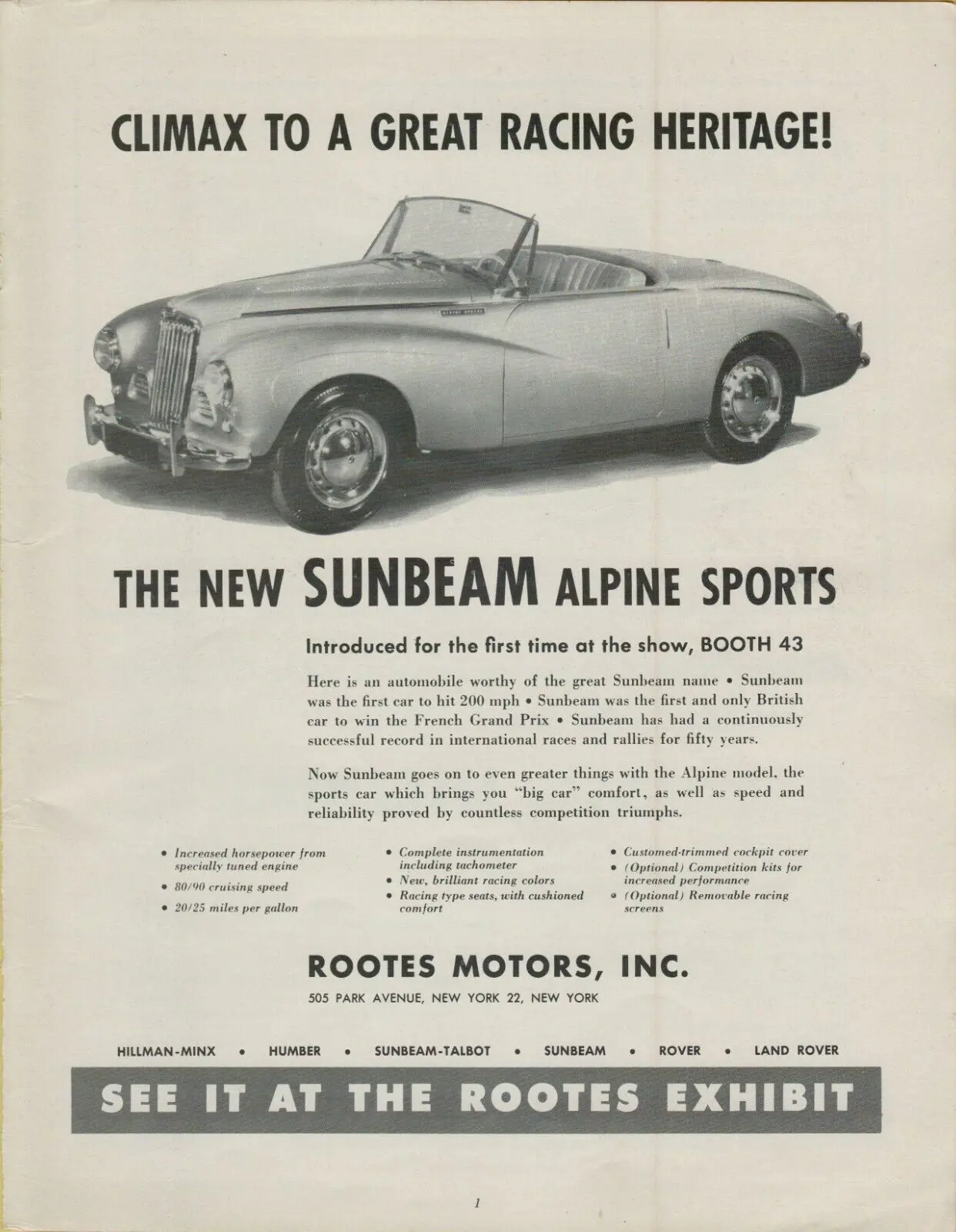THE SUNBEAM ALPINE AT 70
05 April 2023
In 1954, Alfred Hitchcock was planning To Catch a Thief and needed a car for Grace Kelly's 'Frances Stevens'. A Jaguar did not seem to suit the character, nor did a Mercedes-Benz, but the director's wife Alma saw an advertisement for the Alpine.
As a result, the Rootes Group, Sunbeam's parent company, despatched a Sapphire Blue model to Cannes. The film company then shipped the Alpine to Paramount Studios in Hollywood, and when To Catch a Thief premiered on the 3rd of August 1955, the Sunbeam instantly gained cinematic immortality.
The Alpine's narrative starts with the Bournemouth Rootes dealer George Hartwell, who created a one-off two-seater based on the Sunbeam-Talbot 90 Mk. II. He approached Lord Rootes with the idea of building a small number of 'Hartwell Coupes'. However, the firm decided to commission Raymond Lowey Associates to create a production version, to be badged as the 'Alpine' in honour of the 90's rally achievements.

The Rootes Group unveiled the car that was "Bred in the Alps" on the 20th of March 1953; it never wore 'Talbot' badging. "Our only grumble is with the name. The Sunbeam-Talbot really owes its origin to Hillman, Humber and Commer components", noted Motor Sport. The Alpine used the 90 saloon's drum brakes and live rear axle combined with uprated front suspension and shock absorbers, a close ratio gearbox, and a higher steering ratio.
Under the bonnet, the familiar 2.3 litre S4 OHV engine gained a new cylinder head. The power output was 80bhp @ 4200rpm; the top speed was 90 mph with 0-60 in 18 seconds. Surprisingly, the Alpine retained the saloon's steering column gear lever. For the would-be Mike Hawthorne, Rootes offered the factory tuned 'Special' developed by ERA with overdrive, a modified cylinder head, a twin-choke Solex 40 PII carburettor and an 8.0:1 compression ratio.
Mulliners of Bordesley Green hand-made the Alpine bodies, mounted on reinforced chassis from the Sunbeam-Talbot 90 Drophead. Sales were initially for export only, and in the USA, the Alpine cost a steep $2,899. Road & Track found the Alpine to be a paradox. On the one hand, it was:
“a well-executed effort to capture the American market desiring a sports car that will not run in competition, but is designed to ride well, look good, cruise fast.”
However: in theory - and practice - the 2.25-litre Alpine would be running in the 2000-3000cc class, a class that includes the 2.9 Ferrari, (and) the 2.5 Gordini. In the face of that, boosters of the Alpine-for-competition may back down a bit.
British market cars became available in the autumn of 1953 for £1,210 7s 6d. Optional extras included a heater, windscreen washers, Laycock de Normanville overdrive, a cigarette lighter, and a "racing windshield." Asides from Sapphire Blue, the colour choices were Coronation Red, Alpine Mist or Ivory. In the great tradition of British sports cars, the Alpine lacked exterior door locks and featured side screens instead of winding windows. The Terry-Thomas style motorist could specify a badge-bar, which would look "absolutely bang on!"
1953 also saw Stirling Moss, Leslie Johnson, and Sheila van Damm test Alpines along the Jabbeke highway in Belgium. The last-named achieved 120.135 mph, making her Europe's fastest female driver. Rootes heavily modified these Sunbeams with special crankshaft and Solex carburettors. They also lacked windshields and bumpers. A shroud over the passenger seat, a wind-deflecting scuttle cowl ahead of the driver and a flat alloy panel underneath enhanced the bodywork's streamlining.
In the same year, a quartet of factory team cars gained the Coupe des Alpes in the Alpine Rally. Moss went on to achieve his third Coupe des Alpes, plus the Coup d'Or, at the Alpine Rally in the following year. Special production ended in 1954 after just 90 examples and that September, the Alpine received a facelift as the Mk. III. For reasons best known to Rootes, there was never a Mk. II.
The Mk. III featured a tachometer and overdrive as standard, the engine was more powerful, and flashing indicators replaced semaphore trafficators. Production ended in 1955 after just 1,582 examples, Mulliners gaining the contract from Standard-Triumph in 1954 to build the TR2 was probably a factor in the Alpine's demise.
Rootes next employed the Alpine name on a 1.5-litre be-finned two-seater in 1959, while the original version will forever be associated with To Catch a Thief. And for anyone who has not yet seen the picture, this footage will explain why -
